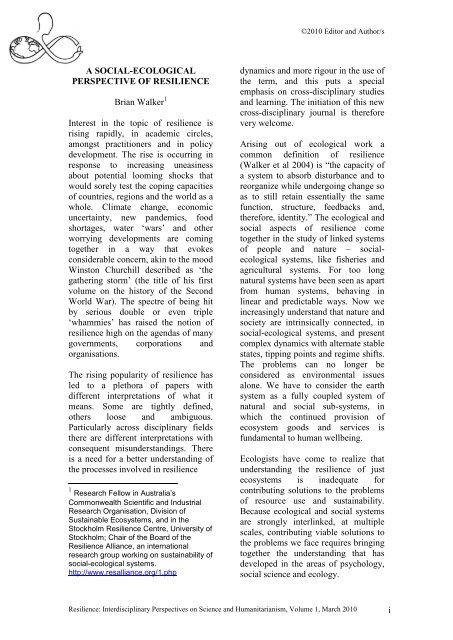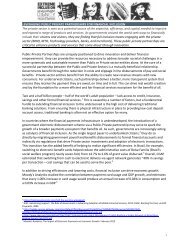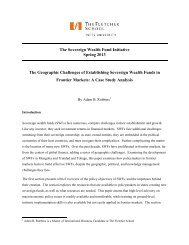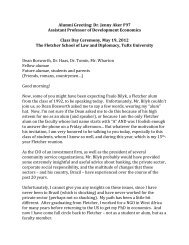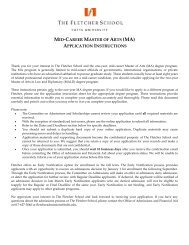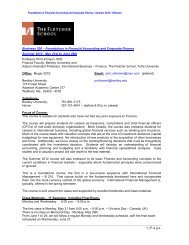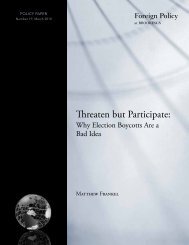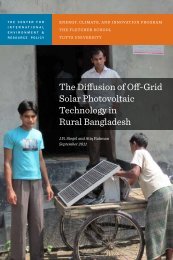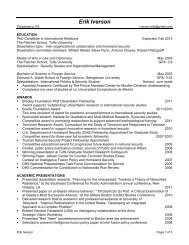A Preface for "Resilience:Interdisciplinary Perspectives in Science ...
A Preface for "Resilience:Interdisciplinary Perspectives in Science ...
A Preface for "Resilience:Interdisciplinary Perspectives in Science ...
- No tags were found...
Create successful ePaper yourself
Turn your PDF publications into a flip-book with our unique Google optimized e-Paper software.
©2010 Editor and Author/sA SOCIAL-ECOLOGICALPERSPECTIVE OF RESILIENCEBrian Walker 1Interest <strong>in</strong> the topic of resilience isris<strong>in</strong>g rapidly, <strong>in</strong> academic circles,amongst practitioners and <strong>in</strong> policydevelopment. The rise is occurr<strong>in</strong>g <strong>in</strong>response to <strong>in</strong>creas<strong>in</strong>g uneas<strong>in</strong>essabout potential loom<strong>in</strong>g shocks thatwould sorely test the cop<strong>in</strong>g capacitiesof countries, regions and the world as awhole. Climate change, economicuncerta<strong>in</strong>ty, new pandemics, foodshortages, water „wars‟ and otherworry<strong>in</strong>g developments are com<strong>in</strong>gtogether <strong>in</strong> a way that evokesconsiderable concern, ak<strong>in</strong> to the moodW<strong>in</strong>ston Churchill described as „thegather<strong>in</strong>g storm‟ (the title of his firstvolume on the history of the SecondWorld War). The spectre of be<strong>in</strong>g hitby serious double or even triple„whammies‟ has raised the notion ofresilience high on the agendas of manygovernments, corporations andorganisations.The ris<strong>in</strong>g popularity of resilience hasled to a plethora of papers withdifferent <strong>in</strong>terpretations of what itmeans. Some are tightly def<strong>in</strong>ed,others loose and ambiguous.Particularly across discipl<strong>in</strong>ary fieldsthere are different <strong>in</strong>terpretations withconsequent misunderstand<strong>in</strong>gs. Thereis a need <strong>for</strong> a better understand<strong>in</strong>g ofthe processes <strong>in</strong>volved <strong>in</strong> resilience1 Research Fellow <strong>in</strong> Australia’sCommonwealth Scientific and IndustrialResearch Organisation, Division ofSusta<strong>in</strong>able Ecosystems, and <strong>in</strong> theStockholm <strong>Resilience</strong> Centre, University ofStockholm; Chair of the Board of the<strong>Resilience</strong> Alliance, an <strong>in</strong>ternationalresearch group work<strong>in</strong>g on susta<strong>in</strong>ability ofsocial-ecological systems.http://www.resalliance.org/1.phpdynamics and more rigour <strong>in</strong> the use ofthe term, and this puts a specialemphasis on cross-discipl<strong>in</strong>ary studiesand learn<strong>in</strong>g. The <strong>in</strong>itiation of this newcross-discipl<strong>in</strong>ary journal is there<strong>for</strong>every welcome.Aris<strong>in</strong>g out of ecological work acommon def<strong>in</strong>ition of resilience(Walker et al 2004) is “the capacity ofa system to absorb disturbance and toreorganize while undergo<strong>in</strong>g change soas to still reta<strong>in</strong> essentially the samefunction, structure, feedbacks and,there<strong>for</strong>e, identity.” The ecological andsocial aspects of resilience cometogether <strong>in</strong> the study of l<strong>in</strong>ked systemsof people and nature – socialecologicalsystems, like fisheries andagricultural systems. For too longnatural systems have been seen as apartfrom human systems, behav<strong>in</strong>g <strong>in</strong>l<strong>in</strong>ear and predictable ways. Now we<strong>in</strong>creas<strong>in</strong>gly understand that nature andsociety are <strong>in</strong>tr<strong>in</strong>sically connected, <strong>in</strong>social-ecological systems, and presentcomplex dynamics with alternate stablestates, tipp<strong>in</strong>g po<strong>in</strong>ts and regime shifts.The problems can no longer beconsidered as environmental issuesalone. We have to consider the earthsystem as a fully coupled system ofnatural and social sub-systems, <strong>in</strong>which the cont<strong>in</strong>ued provision ofecosystem goods and services isfundamental to human wellbe<strong>in</strong>g.Ecologists have come to realize thatunderstand<strong>in</strong>g the resilience of justecosystems is <strong>in</strong>adequate <strong>for</strong>contribut<strong>in</strong>g solutions to the problemsof resource use and susta<strong>in</strong>ability.Because ecological and social systemsare strongly <strong>in</strong>terl<strong>in</strong>ked, at multiplescales, contribut<strong>in</strong>g viable solutions tothe problems we face requires br<strong>in</strong>g<strong>in</strong>gtogether the understand<strong>in</strong>g that hasdeveloped <strong>in</strong> the areas of psychology,social science and ecology.<strong>Resilience</strong>: <strong>Interdiscipl<strong>in</strong>ary</strong> <strong>Perspectives</strong> on <strong>Science</strong> and Humanitarianism, Volume 1, March 2010i
©2010 Editor and Author/sThe word “identity” <strong>in</strong> the def<strong>in</strong>itionabove is important. It implies that thesystem can have the same identitywhile undergo<strong>in</strong>g changes, but only upto a po<strong>in</strong>t. If change exceeds somecritical amount then the system is nolonger able to self-organise <strong>in</strong> the samek<strong>in</strong>d of way, and it changes to someother way of function<strong>in</strong>g, with adifferent structure and differentregulat<strong>in</strong>g feedbacks – and it developsa different identity (Cumm<strong>in</strong>g et al2005).It was this word „identity‟ thattriggered the <strong>in</strong>itial <strong>in</strong>teraction betweenme and Astier Almedom (the <strong>in</strong>itiatorof this Journal). She, too, had focussedon identity as the def<strong>in</strong><strong>in</strong>g feature thatcaptured critical change <strong>in</strong> thepsychosocial transition people make <strong>in</strong>the aftermath of disasters (Almedom,2004; Almedom and Tumw<strong>in</strong>e 2008).<strong>Resilience</strong> of <strong>in</strong>dividuals, families,communities and <strong>in</strong>stitutions isdeterm<strong>in</strong>ed by their capacity toma<strong>in</strong>ta<strong>in</strong> their identity whileundergo<strong>in</strong>g trans<strong>for</strong>mations (adapt<strong>in</strong>gto adversity) through persistence withrout<strong>in</strong>e functions and rituals whichmake them who they are as people,communities, cultures, nations and/or<strong>in</strong>stitutions. Human agency anddeliberate action to ma<strong>in</strong>ta<strong>in</strong> one‟s<strong>in</strong>tegrity is where we differ <strong>in</strong> th<strong>in</strong>k<strong>in</strong>gabout identity. An ecosystem‟s identityis described by the functions andcontrols that dist<strong>in</strong>guish it, whilehuman identity is imbued with agency,customs, rituals, and deliberate action.Ecosystems and people are sel<strong>for</strong>ganis<strong>in</strong>g,complex adaptive systemswith non-l<strong>in</strong>ear dynamics. They canexist <strong>in</strong> multiple (alternate) stabilitydoma<strong>in</strong>s, or „regimes‟, and the shiftfrom one to another is triggered whenthey cross some critical threshold. Anda crucial po<strong>in</strong>t is that the positions ofsuch thresholds are not fixed. What wedo to ecosystems, and the k<strong>in</strong>ds ofnatural and social environments thatpeople live <strong>in</strong>, <strong>in</strong>fluence how muchthey can change be<strong>for</strong>e they reach athreshold, which is a measure of theirresilience.If there is no possibility of „regimeshifts‟ (cf Scheffer and Carpenter2003), no possibility of „tipp<strong>in</strong>g po<strong>in</strong>ts‟<strong>in</strong> human behaviour, or thresholdeffects <strong>in</strong> ecosystems, then there is nofundamental problem <strong>in</strong> resourcemanagement or <strong>in</strong> human welfarebecause the system is always smoothlyreversible. It is globally stable andrecovery is always possible withoutmajor <strong>in</strong>terventions. In non-l<strong>in</strong>earsystems, however, the likelihood ofalternate system regimes is high and ashift (<strong>in</strong>tended or un<strong>in</strong>tended) from oneto the other can be irreversible, or veryhard to reverse. <strong>Resilience</strong>management there<strong>for</strong>e places anemphasis on identify<strong>in</strong>g alternateregimes and what determ<strong>in</strong>es thethresholds between them.I conclude with a few observations,emerg<strong>in</strong>g from comparative analysesof resilience <strong>in</strong> various regions of theworld (see, <strong>for</strong> example, Walker et al2006), on actions that can build orreduce resilience.Prob<strong>in</strong>g the boundaries of resilienceKeep<strong>in</strong>g th<strong>in</strong>gs constant reducesresilience. A common objective ofpolicies aimed at optimiz<strong>in</strong>g someparticular product or outcome is toidentify an „optimal‟ state of thesystem, and then to somehow try andkeep it <strong>in</strong> that particular state. In fact,keep<strong>in</strong>g a system <strong>in</strong> one particular stateleads to self-organized changes thatmake the system less and less resilient.As an example, prevent<strong>in</strong>g fire <strong>in</strong> a<strong>for</strong>est <strong>in</strong> an attempt to keep it <strong>in</strong> its<strong>Resilience</strong>: <strong>Interdiscipl<strong>in</strong>ary</strong> <strong>Perspectives</strong> on <strong>Science</strong> and Humanitarianism, Volume 1, March 2010ii
©2010 Editor and Author/spresent state leads eventually to theloss of species able to withstand fire.To keep a <strong>for</strong>est resilient to fire it isnecessary to periodically burn it.Push<strong>in</strong>g problems up-scaleIncreas<strong>in</strong>g resilience at one scale canreduce resilience at other scales. Acommon problem is that attempts to<strong>in</strong>crease resilience at small scales (<strong>for</strong>example, <strong>in</strong>dividual farmers) leads tothe system at a higher scale (thefarm<strong>in</strong>g system as a whole) becom<strong>in</strong>gless resilient. The European “ButterMounta<strong>in</strong>” and the Australian “WoolMounta<strong>in</strong>” were examples of this.Pursu<strong>in</strong>g efficiency, narrowlydef<strong>in</strong>edShort term cost cutt<strong>in</strong>g frequentlyresults <strong>in</strong> gett<strong>in</strong>g rid of „redundancies‟,which later turn out to have beenalternate ways of do<strong>in</strong>g th<strong>in</strong>gs <strong>in</strong>response to shocks. Response diversityis a key part of be<strong>in</strong>g resilient.Secondary, un<strong>in</strong>tended effects oftenoccur across scales and across doma<strong>in</strong>s(social, economic, ecological),trigger<strong>in</strong>g threshold effects where theywere not expected. You cannotunderstand or manage a socialecologicalsystem by focus<strong>in</strong>g at onlyone scale and on one doma<strong>in</strong>.The need <strong>for</strong> both general andspecified resilienceChannel<strong>in</strong>g all attention and ef<strong>for</strong>t <strong>in</strong>tomanag<strong>in</strong>g <strong>for</strong> particular aspects ofresilience and associated thresholdscan <strong>in</strong>advertently reduce resilience <strong>in</strong>other ways. There is there<strong>for</strong>e a need toconsider both general and specifiedresilience. General resilience <strong>in</strong>volvessuch th<strong>in</strong>gs as diversity, tightness offeedbacks and modularity. While it isreasonably straight<strong>for</strong>ward to estimatethe costs of ma<strong>in</strong>ta<strong>in</strong><strong>in</strong>g generalresilience (some <strong>for</strong>m of <strong>for</strong>egoneextra yield or profit that it entails), it ismuch harder to estimate the costs ofnot ma<strong>in</strong>ta<strong>in</strong><strong>in</strong>g it (s<strong>in</strong>ce it isunspecified).Enhanc<strong>in</strong>g resilience vs.trans<strong>for</strong>mationIf a threshold has been crossed, orcross<strong>in</strong>g it is <strong>in</strong>evitable, further ef<strong>for</strong>tsat adaptation amount to „digg<strong>in</strong>g thehole deeper‟. In such cases the need isto trans<strong>for</strong>m <strong>in</strong>to a different k<strong>in</strong>d ofsystem, with different ways of mak<strong>in</strong>ga liv<strong>in</strong>g.The question fac<strong>in</strong>g policy makers andplanners will <strong>in</strong>creas<strong>in</strong>gly become:“which parts of our (locality, region,country) need enhanced resilience <strong>in</strong>order to ensure their present states cancont<strong>in</strong>ue, and which parts need to betrans<strong>for</strong>med?”REFERENCESAlmedom, A.M. “Factors that mitigate war<strong>in</strong>ducedanxiety and mental distress.” Journalof Biosocial <strong>Science</strong> (2004): 445-461. Pr<strong>in</strong>t.Almedom, A. M. and Tumw<strong>in</strong>e, J. K.“<strong>Resilience</strong> to Disasters: A Paradigm Shiftfrom Vulnerability to Strength.” AfricanHealth <strong>Science</strong>s Special Issue on <strong>Resilience</strong>(2008) 8: S1-S4. Pr<strong>in</strong>t.Cumm<strong>in</strong>g, G. S. et al., “An exploratoryframework <strong>for</strong> the empirical measurement ofresilience.” Ecosystems (2005): 975–987.Pr<strong>in</strong>t.Scheffer, M. and Carpenter S. R. “Catastrophicregime shifts <strong>in</strong> ecosystems: l<strong>in</strong>k<strong>in</strong>g theory toobservation.” Trends <strong>in</strong> Ecology and Evolution(2003): 648-656. Pr<strong>in</strong>t.Walker, B. H. et al., “<strong>Resilience</strong>, adaptabilityand trans<strong>for</strong>mability <strong>in</strong> social-ecologicalsystems.” Ecology and Society (2004): 3. Web.Walker, B. H. et al., “Explor<strong>in</strong>g resilience <strong>in</strong>social-ecological systems through comparativestudies and theory development: Introductionto the Special Issue.” Ecology and Society(2006): 12. Web.<strong>Resilience</strong>: <strong>Interdiscipl<strong>in</strong>ary</strong> <strong>Perspectives</strong> on <strong>Science</strong> and Humanitarianism, Volume 1, March 2010iii


